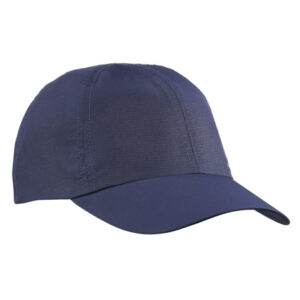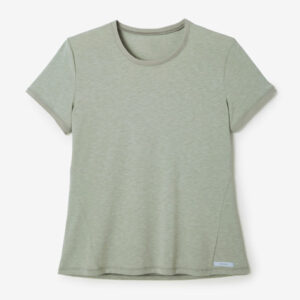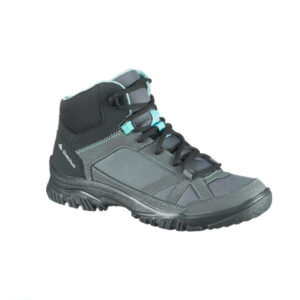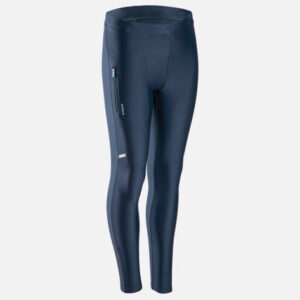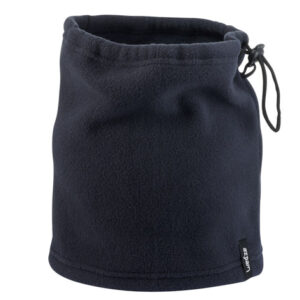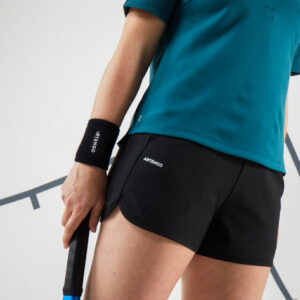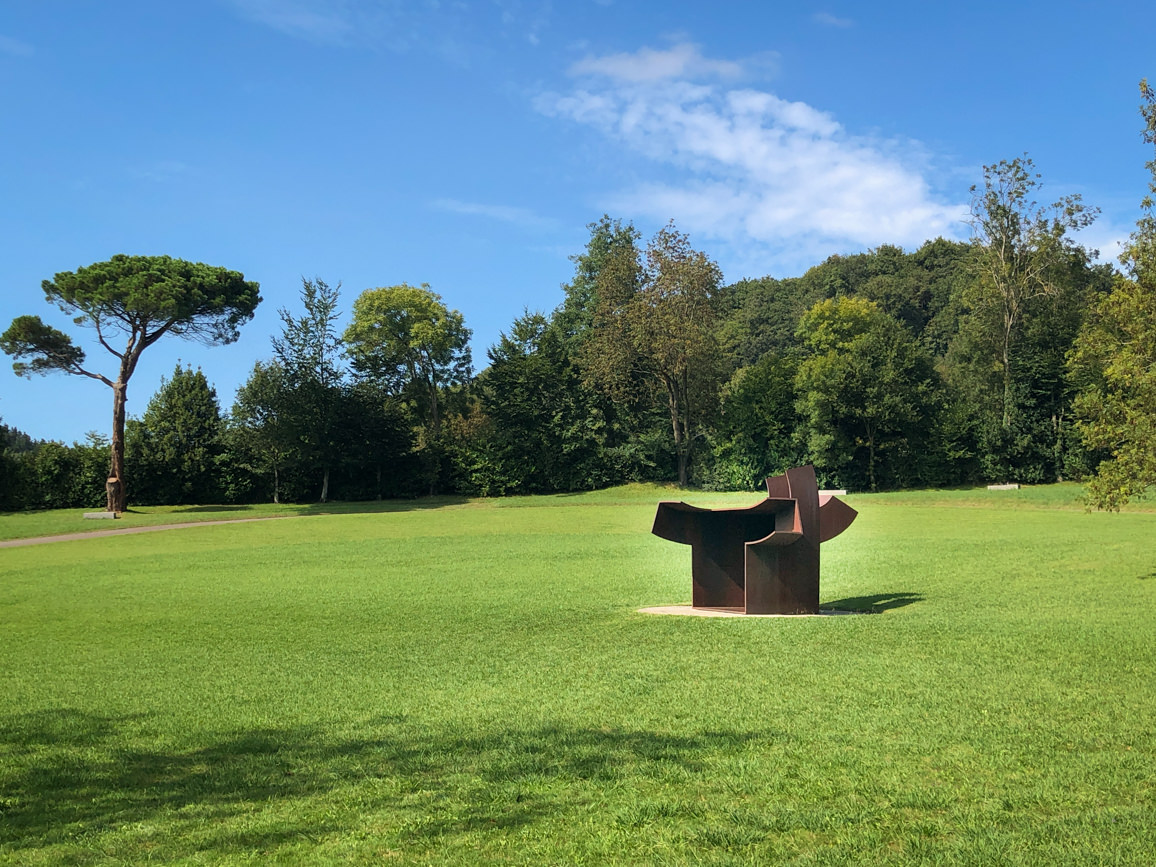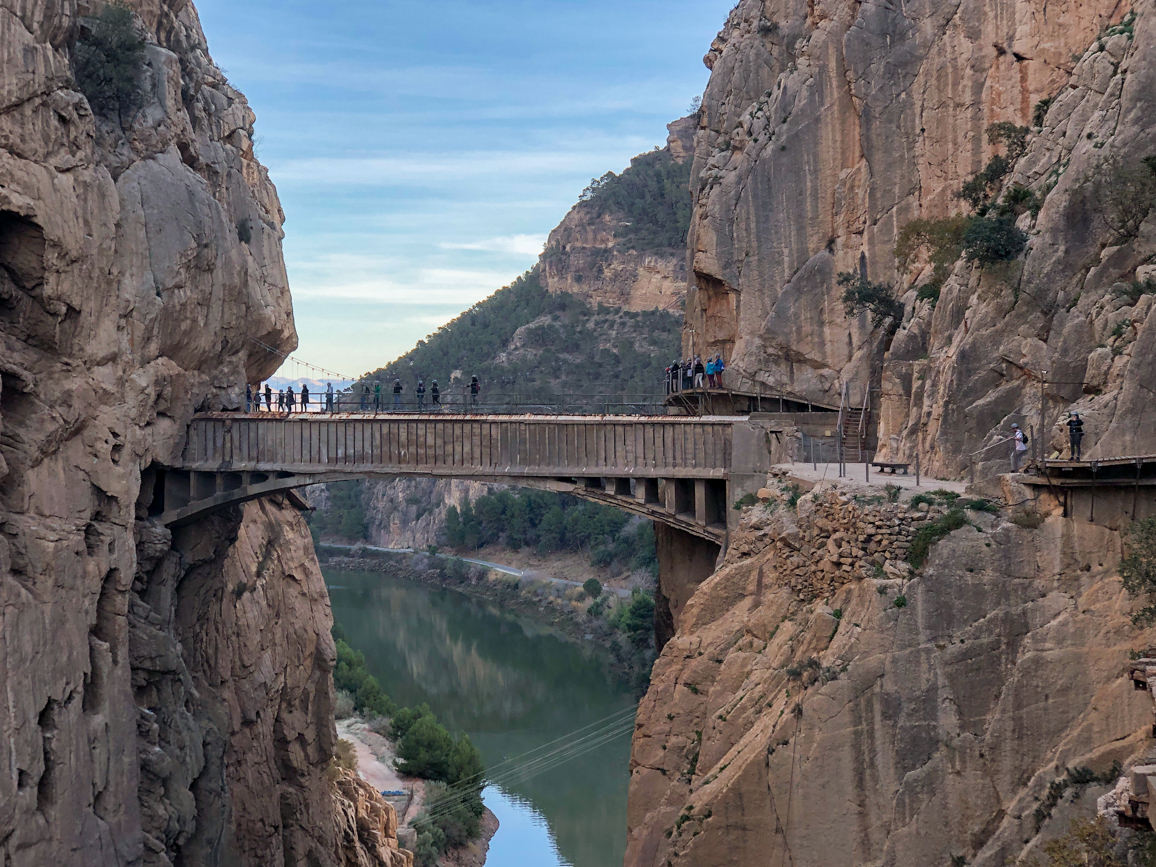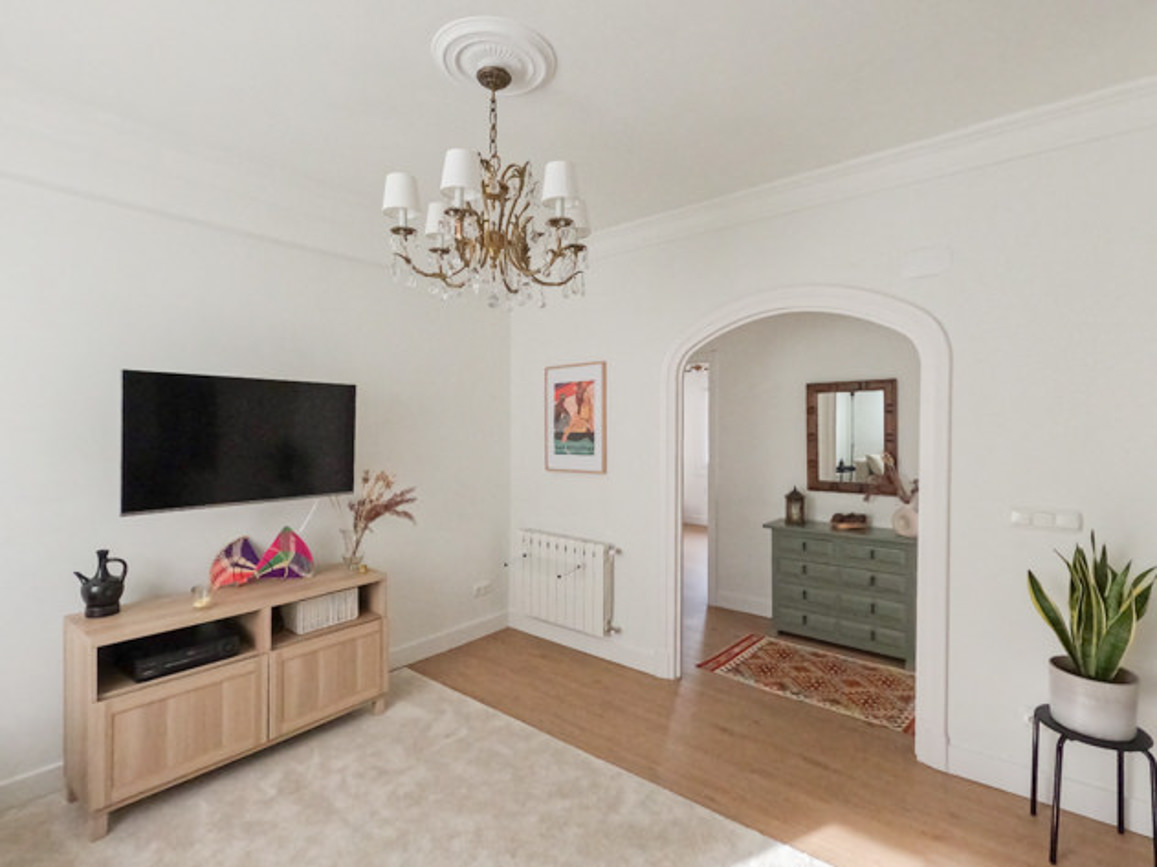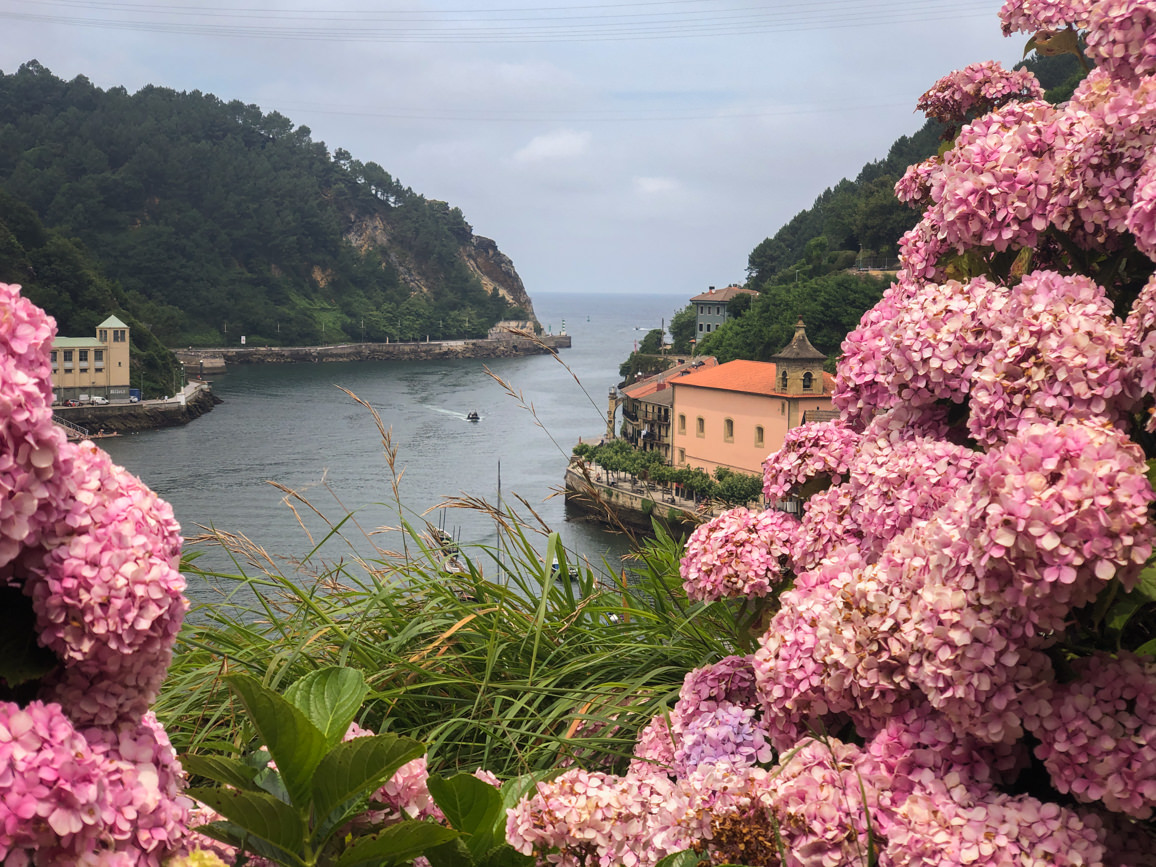
Camino de Santiago: hiking from Irún to Deba along the ‘Camino del Norte’
For centuries, the ‘Camino de Santiago‘ has been a captivating experience for people taking on this pilgrimage route. During three days this summer, I had the chance of joining some friends along the first stages of the Camino del Norte, from Irún to Deba. Keep on reading to learn more about the Camino, our hiking itinerary and some tips that might help you plan accordingly. At the end of this post you will also find a map with all the locations mentioned here.
History of the ‘Camino de Santiago’
Legend has it that the body of Saint James the Apostle (Santiago in Spanish) was discovered in the 9th century in the northwestern region of Galicia in Spain, and then buried in the cathedral of Santiago de Compostela. In an effort to attract pilgrims from all over the world, King Alfonso II promoted the construction of a large temple in order to compete with religious destinations such as Rome or Jerusalem. Over the centuries, a vast network of trails (known as ´caminos´ or ways in Spanish) developed to connect major cities of Europe with Santiago de Compostela in Spain. All of them make up the ‘Camino de Santiago‘ or the Way of Saint James, with some of the most famous routes being the Camino Francés, the Camino Portugués or the Camino del Norte.
Traditionally, pilgrims did the Camino on foot and for religious reasons. However, nowadays, there are a variety of ways to discover the Camino de Santiago (be it by riding a horse, a bike or a car), as well as many motives to do so (be they spiritual or simply touristic).
Camino del Norte
Out of the many routes that make up the Camino de Santiago, the Camino del Norte (also known as the Northern Way or Donejakue Bidea in Basque) is one of the most primitive trails. The itinerary runs along the Atlantic coast in northern Spain until Ribadeo, before turning southwest. Around 800 kilometers separate the starting point in my hometown, Irún, from the final destination in Santiago.
Much of the Camino del Norte runs through tourist areas such as San Sebastián, Bilbao or Santander, and combines highly urbanized areas with others of great natural beauty. Given the mountainous orography of the Atlantic coast, you will find the Camino del Norte is frequently uneven, especially in the Basque Country.

El Caminito del Rey: the most popular hiking trail in Málaga
Reserva Nacional de Fauna Andina Eduardo Avaroa (I)
Reserva Nacional de Fauna Andina Eduardo Avaroa (II)
What to see and do in Iceland in 4 days
Below I have detailed the itinerary of the three days I hiked along the Camino del Norte. Under each destination, I’ve included relevant information such as what to see or where to eat. By the way, the cities we passed by are mentioned both in Spanish and Basque (in parenthesis).
For your ease of reference, I also added links to Gronze, the website I used to plan each stage. Make sure to browse it because it features a ton of useful information, from detailed itineraries to accommodation options along the way.
Day 1: Irún – Pasajes, the first stage of the Camino del Norte in Spanish soil
Although the original stage goes from Irún to San Sebastián, we stopped in Pasajes for logistical reasons since my friends couldn’t find any accommodation in San Sebastián.
| PRACTICAL INFORMATION: |
|---|
| Distance from Irún to Pasajes: 16 km |
| Hiking time from Irún to Pasajes: around 5h |
| Itinerary on Gronze.com from Irún to San Sebastián |
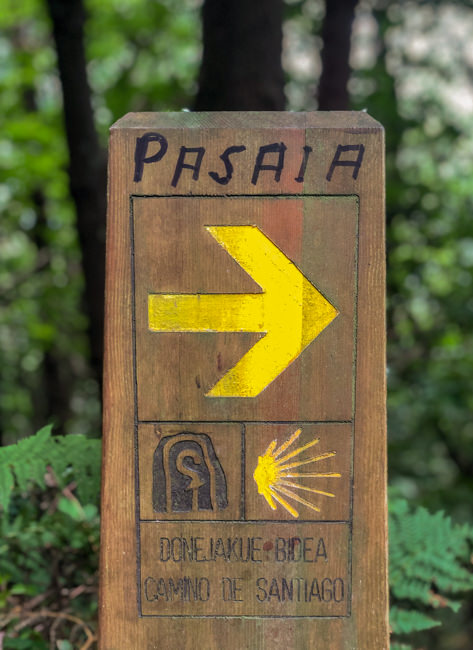
Irún
Welcome to my hometown and to the official starting point of the Camino del Norte in Spain. Located right on the border with France, Irún marks the beginning of the adventure.
Follow the signs along the way (a yellow arrow or shell) to reach the neighboring town of Fuenterrabía (Hondarribia).
Want to know more about Irún? Read these other posts for inspiration!
My dearest ‘fiestas’: San Pedro & San Marcial
Asador Trinkete Borda: my favorite restaurant in Irún
The story behind one of my favorite sweets: ‘opilla’
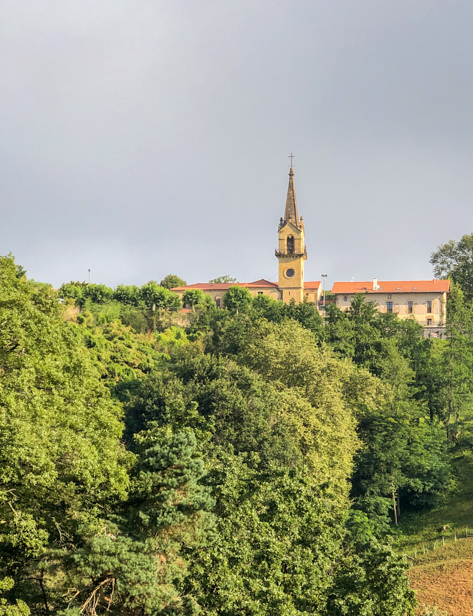
Fuenterrabía (Hondarribia) and monte Jaizkibel
You will enter the city of Hondarribia through the neighborhood of Amute. After walking along vegetable gardens, you will begin to ascend towards monte Jaizkibel at 547 meters high. On your way, you will pass by a hermitage (ermita de Santiagotxo) and a sanctuary (santuario de Guadalupe). From there, you’ll be able to enjoy a panoramic view over the Txingudi Bay, encompassing Hendaye in France as well as Hondarribia and Irún in Spain.
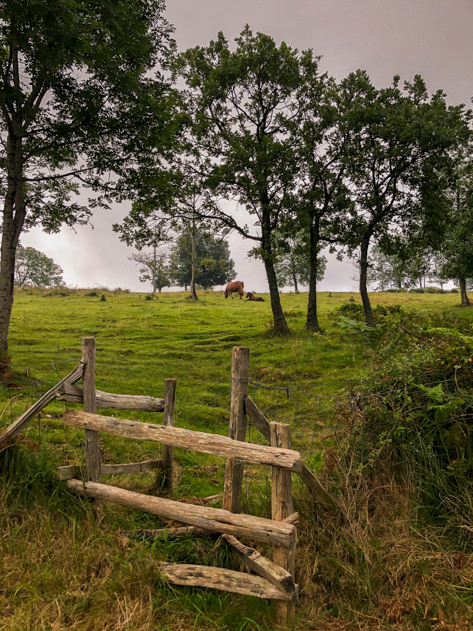
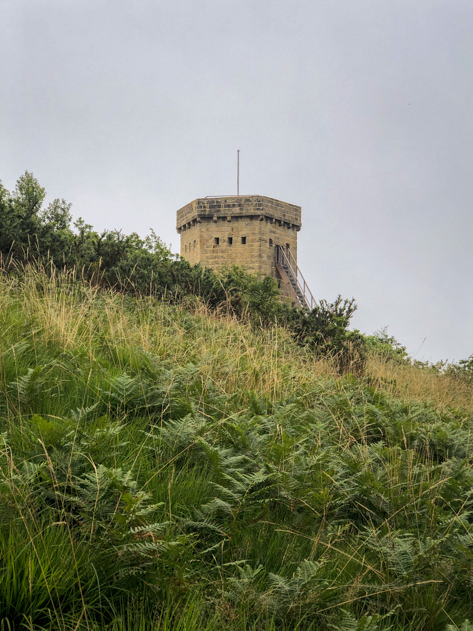
When walking on mount Jaizkibel, you will notice a series of five rock watchtowers (known as ‘atalayas‘) overlooking the area. As you can imagine given their strategic position, they were built as defensive structures in addition to some nearby forts. More recently, various antennas were also installed on top of Jaizkibel.
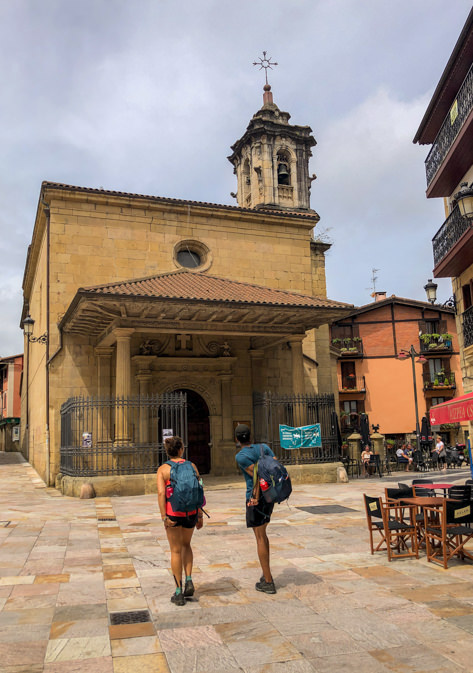
Lezo
After descending from mount Jaizkibel, you will get to the village of Lezo. Housing over 6000 inhabitants, the main sites of interest include the following: Plaza del Santo Cristo (a square with an homonymous basilica and the City Hall), Calle Mayor and Palacio Andreone. On your way to Pasajes, you will see the vast port.
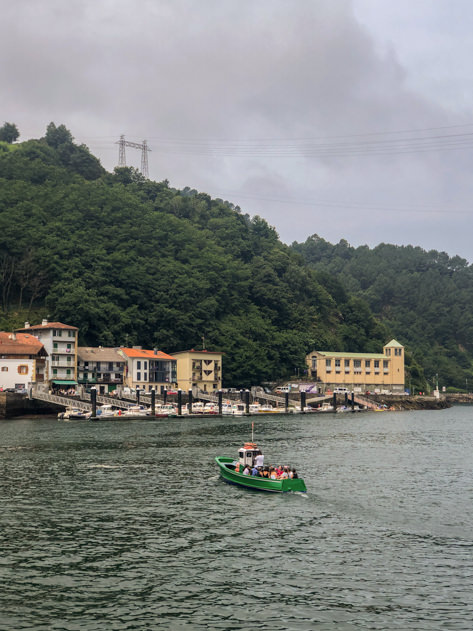
Pasajes (Pasaia)
Shortly after leaving Lezo, we arrived to Pasajes de San Juan (Pasai Donibane), which was the last stop of our stage on day one along the Camino del Norte.
The city of Pasajes is located in the estuary of the Oyarzun river before reaching the Atlantic Ocean, and it is made up of four distinct districts (Pasai San Pedro, Pasajes de San Juan or Pasai Donibane, Pasai Antxo and Trintxerpe). Pasai Donibane and Pasai San Pedro concentrate most of the tourist highlights, including various churches (Iglesia del Santo Cristo de la Bonanza, Iglesia Parroquial de San Juan Bautista, Iglesia Parroquial de San Pedro), the houses of distinguished people such as the famous writer French Victor Hugo and the sailor Blas de Lezo, a couple of museums (Albaola Itsas Kultur Faktoria and Mater – Barco Museo Ecoactivo) or the colorful Plaza de Santiago.
Of course, the port (Puerto de Pasajes) is an obvious site of interest and is actually one of the busiest on the Atlantic coast.
Another attraction in Pasaia are the green boats that will take you from Pasai San Pedro to Pasai Donibane, connecting both shores in just two minutes.
Last but not least, below are some recommendations on where to eat in Pasajes de San Juan if you’d like to enjoy the local Basque food:
- Alabortza Puntetako Kantina: located at the end of the Paseo de Puntas, this bar is known for its grilled sardines, cod omelette and homemade fried calamari. You can eat there or take your food away. No reservations are allowed. The bar typically opens between the Holy Week and the end of September. You can also check out the nearby Kalaburtza beach if you feel like it.
- Casa Cámara: founded in 1844, this renowned restaurant overlooking the estuary of Pasajes has been serving exquisite Basque gastronomy ever since. Fish and seafood are among their specialties. Now ran by the fourth generation of the Cámara family, the restaurant even features a hatchery in the midst of the dining area.
- Plaza de Santiago: you will find a number of bars and restaurants in this charming square.
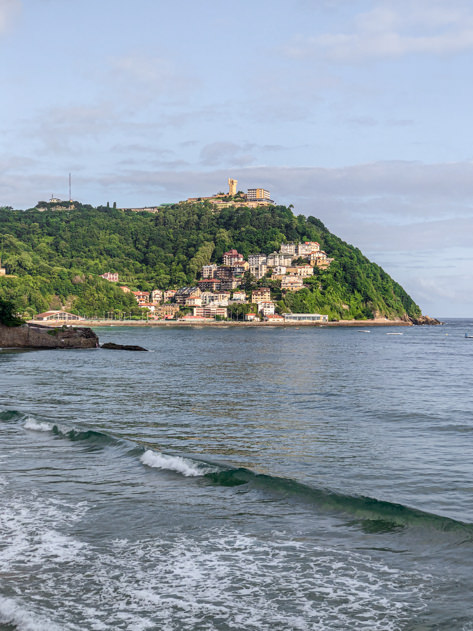
Day 2: San Sebastián – Zarauz, discovering elegant cities along the Camino del Norte
| PRACTICAL INFORMATION: |
|---|
| Distance from San Sebastián to Zarauz: 22 km |
| Hiking time from San Sebastián to Zarauz: 6h30 |
| Itinerary on Gronze.com from San Sebastián to Zarauz |
San Sebastián (Donostia)
This itinerary begins in San Sebastián, the capital of the Basque province of Guipúzcoa. We left from the City Hall, a former casino that overlooks the famous playa de la Concha.
Keep walking along the promenade until you reach the next beach, playa de Ondarreta. From there, you’ll have to ascend monte Igeldo. At 181 meters high, take a break to enjoy the panoramic views of the city and the coastline before continuing the hike on the Camino del Norte towards Orio and Zarauz.
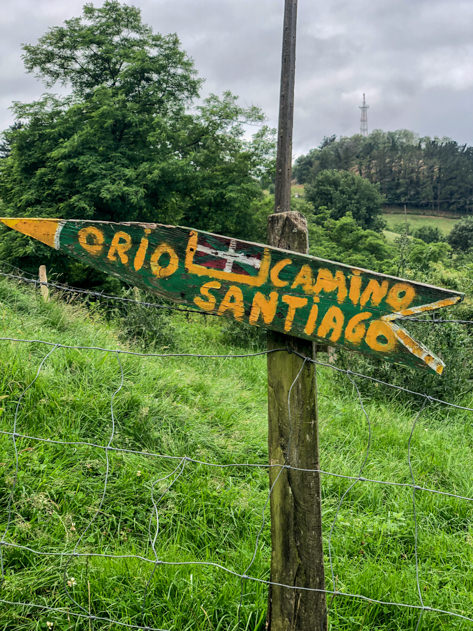
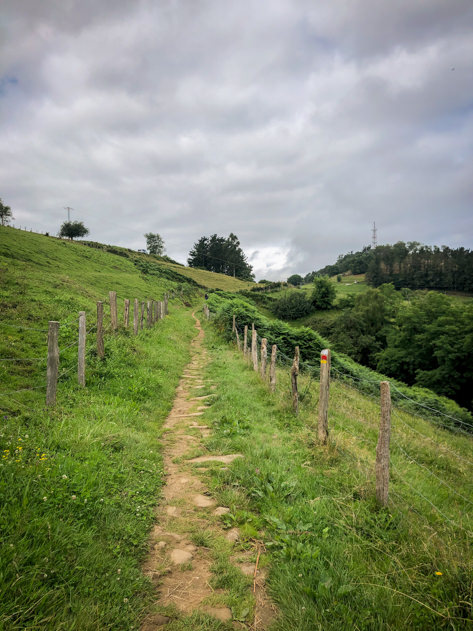
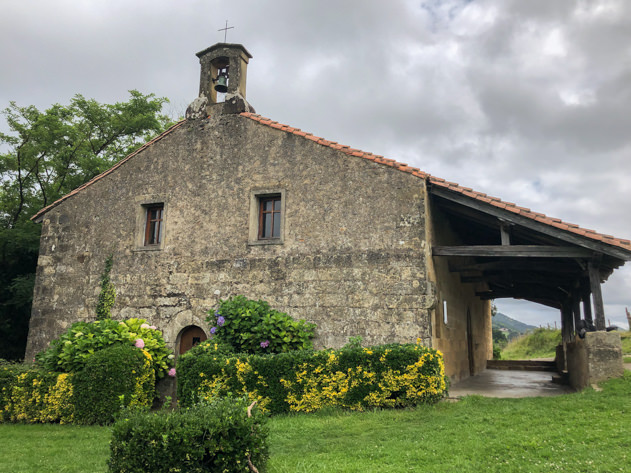
Orio
This small fishing village with over 6000 inhabitants lies at the intersection of the green mountains, the Atlantic Ocean and the estuary of the Oria river. Orio is deeply connected to the Camino de Santiago, housing some heritage treasures such as the hermitage of San Martín de Tours or a Baroque church in the midst of the medieval Old Town (iglesia parroquial de San Nicolás de Bari). Given its location by the coast, you will find two beaches: Antilla and Oribarzar.
Rowing is extremely popular in Orio and you will see yellow flags all around the village showing support to the local rowing team.
Last but not least, you can’t leave Orio without trying grilled meat or fish, especially the red sea bream (besugo). Most bars and restaurants are located around the main square (Herriko Plaza). Here are some recommendations about where to eat in Orio: Bodegón Asador Joxe Mari, Zaharren Babeslekua and Kolon Txiki (we shared various plates here and they were all delicious).
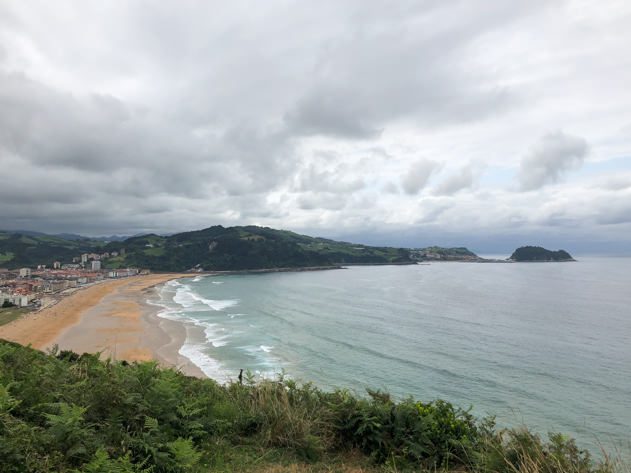
Zarauz (Zarautz)
After visiting Orio, cross the Oria river and take the coastal trail (Camino de la Costa). Following a long ascent, you’ll reach the Gran Camping Zarautz. From there, you’ll be able to enjoy imposing views over the vast beach of Zarauz and its beautiful surroundings.
Zarauz is a popular holiday destination thanks to its 2.5 kilometer long beach and its colorful beach tents, especially among surfers. Other sites of interest include the Narros Palace, various noble houses (Zarauz, Dotorekua, Portu, Torre Luzea), a church (iglesia parroquial de Santa María la Real) and two monasteries housing franciscans and nuns of the order of Saint Claire.
Grilled fish and txakoli white wine rank high on the gastronomic agenda in Zarautz. A recommended place where you can try the Basque cuisine is the Hotel Karlos Arguiñano, ran by the celebrity chef and his family.
Day 3: Zumaia – Deba, hiking the Camino del Norte along breathtaking flysch formations
Although the original stage of the Camino del Norte goes from Zarauz to Deba, we decided to do it backwards and to skip the last part (Zumaia-Zarauz) for logistical reasons. Hence, our itinerary started in Deba and finished in Zumaia.
Out of the three stages of the Camino del Norte I’ve hiked so far, this was my absolute favorite because of the incredible views over the rugged coastline and the breathtaking flysch landscapes going back millions of years. You can walk really close to the coast and even stop at a flysch beach (Sakoneta) at some point.
| PRACTICAL INFORMATION: |
|---|
| Distance from Deba to Zumaia: 14 km |
| Hiking time from Deba to Zumaia: 4h15 |
| Itinerary on Gronze.com from Zarauz to Deba |
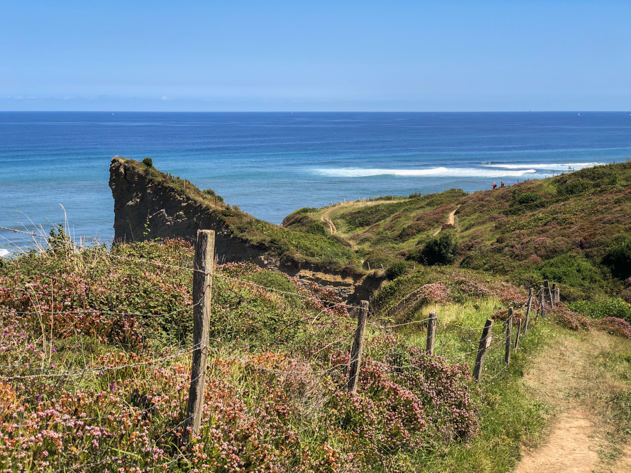
Deva (Deba)
After leaving the village of Deba and going uphill on a steep narrow path, the first stop will be an hermitage overlooking the coastline (ermita de Santa Catalina). From there, you will enjoy an incredible view over lush green rolling hills and various mountains in the countryside such as Andutz or Arno.
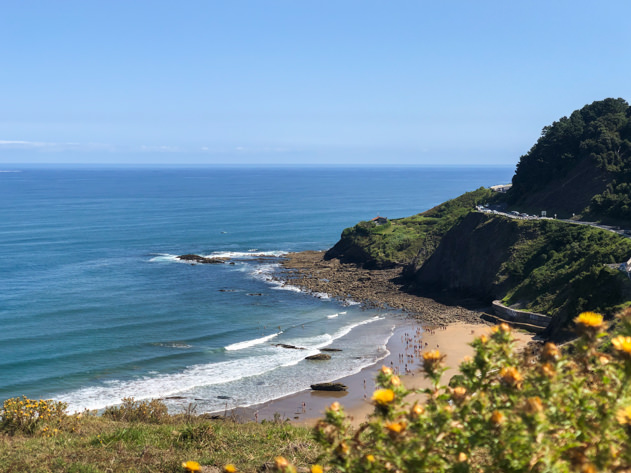
During the hike from Deba to Zumaia, you will see outstanding rock layers known as ‘flysch‘, signaling that you’ve entered Geoparkea. This 13 kilometer stretch of coastline encapsulating 60 million years of history written into the rocks is a testimony of the impact of a giant asteroid and the extinction of dinosaurs millions of years ago. The Geoparkea encompasses the villages of Zumaia, Deba and Mutriku and is part of the UNESCO Global Geopark network since 2010. You can of course see these flysch formations by foot, but it is even better to explore them in a guided tour by boat. Make sure to stop along the way in the following viewpoints: Itsaspe, Mendatagaina, Aitzuri, Sakoneta, Portutxiki, Baratzazarrak, Andikaerreka and Algorri.
The Camino del Norte route towards Zumaia continues up and down. While you’re hiking, you will find traditional Basque farms (caseríos or baserriak), animals (cows, sheep, horses) and even tall vineyards growing txakoli, a refreshing local white wine. Originally, this wine comes from nearby Getaria and has a certificate of origin, although it is also grown in other parts of the Basque coast (namely Guipúzcoa and Vizcaya).
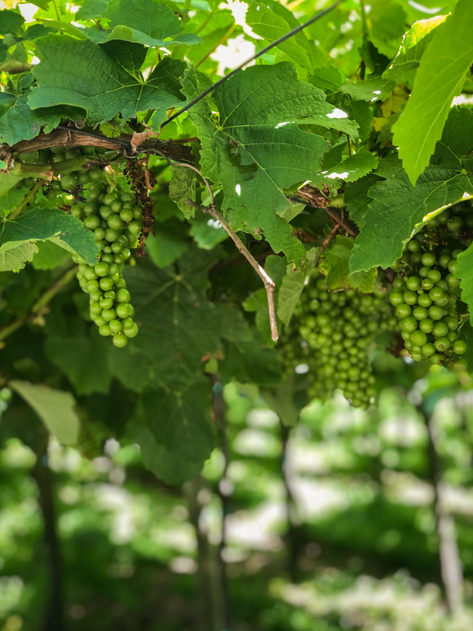
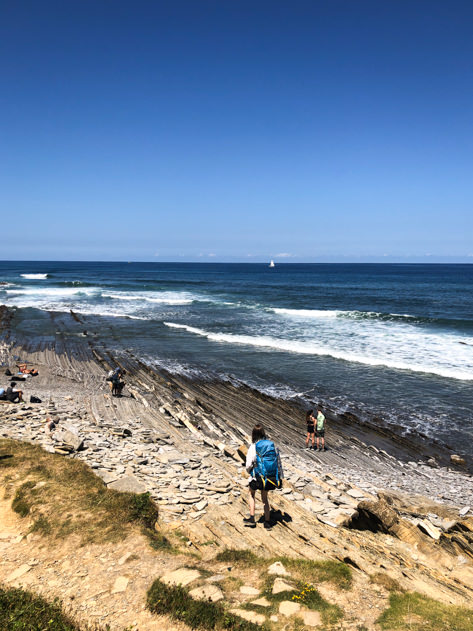
PRACTICAL INFORMATION ON DEBA:
- Parking: you can park for free either at the Danobat parking located between the Deba Euskotren station and the football field in Errota Zar, or by the Santiago beach.
- Beaches: Santiago (the biggest one and closest to the village), Itxaspe (difficult to reach), Sakoneta (wild beach)
- Main sites of interest: Iglesia de Santa María de Deba (Gothic church built in the 15th century with outstanding cloisters), ermita de San Roque (hermitage up in the mountains), ermita de Santa Catalina
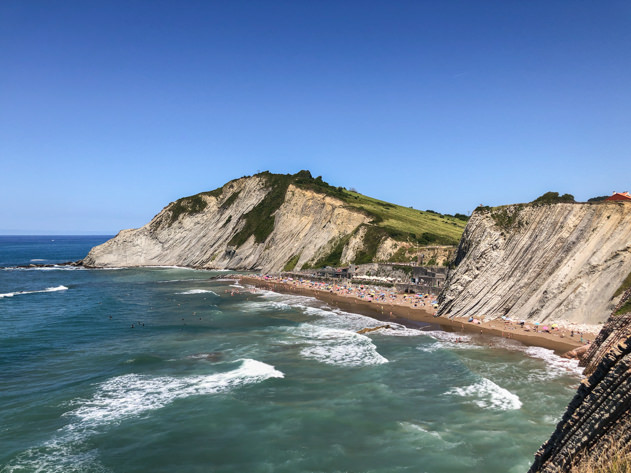
Zumaya (Zumaia)
After hiking from nearby Deba along the Camino del Norte, you will reach the fishing village of Zumaia. Or should I call it Dragonstone instead? As a matter of fact, the dramatic beaches and landscapes of Zumaya were featured in the worldwide famous Game of Thrones series.
The first point of interest that you will encounter is an hermitage (ermita de San Telmo) overlooking the impressive flysch formations around it, and the Itzurun beach in particular.
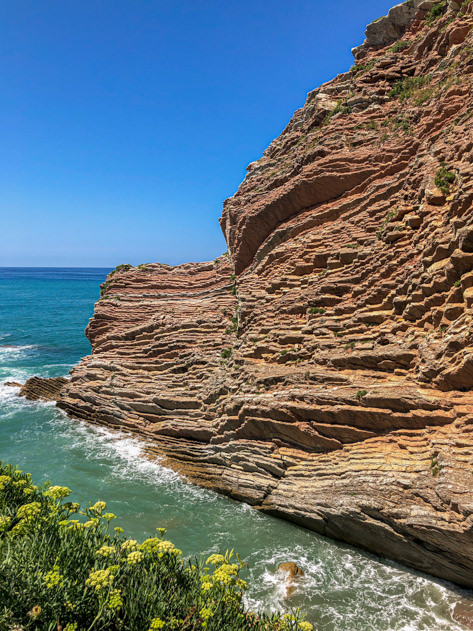
The main sites to visit in Zumaia are detailed below:
- Heritage: the old town of this small village revolves around a Gothic church built between the 13th and 14th centuries (iglesia de San Pedro). Other highlights worth exploring in Zumaia include the Ubillos and Olazabal palaces, the Sanjuaniturri fountain, or the hermitages (Arritokieta and San Telmo).
- Museums: Espacio Cultural Ignacio Zuloaga (devoted to the work of this Basque painter), Kantauri Ondare Museoa (naval museum)
- Beaches: Itzurun (featured in Game of Thrones), Santiago (big beach on the other side of the Urola river), Aitzuri (difficult access)
- Recommended restaurants: Aita Mari, Ubera, El txoko de Mikel Bermejo
- In case you’d like to walk a bit more after the hike, I suggest you go from the harbor (puerto de Zumaia) to the lighthouse (faro).
Get inspired by my hike from Deba to Zumaia:
Tips for the Camino
Hiking along the Camino de Santiago is certainly an unforgettable experience. However, let me share some tips that I think will be helpful when preparing your itinerary:
Get your stamps for the ‘credencial’
Before starting your hiking adventure on the Camino, make sure to purchase a document called ‘credencial‘. Similar to a pilgrim’s passport, it will give you access to overnight lodging along the route, provided there is space where you’re staying. Stamping your credencial in the cities and refuges on your way to Santiago de Compostela not only ensures that you’re following the official itinerary, it will also entitle you to receive a certificate of completion of the pilgrimage upon arrival to the final destination (known as ‘compostela‘).
Accommodation tricks
Many people take onto the Camino every year given its popularity. Even though you’re supposed to have access to hostels along the Camino when carrying your credencial, your accommodation might be fully booked by the time you get there. Note that many hostels tend to run on a first come, first served basis. In order to increase their chances and to also avoid the heat, especially during the busy summer months, many pilgrims opt for hitting the trails early in the morning (around 6 or 7am). Should you not find any accommodation in your destination, you can always look for alternative apartments or hotels in nearby locations off the beaten track.
Pack light but bring your comfy essentials
We all know that hiking for various days or weeks in a row can be hard on your body. Indeed, it is crucial to travel light while feeling comfortable. Getting a good pair of hiking boots will be key for a seamless adventure along the Camino. Another aspect you may be worried about is carrying a lot of weight on your back and shoulders day in and day out. The Spanish Postal Service (Correos) offers to bring your backpack or luggage between your initial and final destinations and all the stops along the way. This is a brilliant idea in case you just want to bring the bare essentials with you and forget about the heavy stuff.
Drink plenty of water
Staying hydrated while hiking the Camino is of outmost importance. Make sure to have enough water with you at all times. Luckily, you will find many fountains along the way.
Take care of your body
Hiking for five of six hours every day or even weeks is no easy task, and your body will thank you if you train and prepare accordingly before, during and after taking onto the Camino. Make sure to stretch in order to avoid cramps and stiffness after exercising. Comfortable shoes and breathable clothing will also help.

Shop my look on the Camino del Norte
As mentioned before, it is key to feel comfortable while hiking for hours. Below are some of the sports products that I used during my itinerary along the Camino. You can also check out my Decathlon affiliate profile to create your own look.
Map of my itinerary along the Camino del Norte
Below you will find a map where I pinpointed all the locations I stopped by during my hike along the Camino del Norte. You can save it for further reference.
How did you enjoy this itinerary along the Camino del Norte in Basque territory? Check out these posts for further inspiration:
Have you hiked the Camino de Santiago or have you been along the Camino del Norte? Feel free to share your comments below and stay tuned for additional stages on this legendary trail.
¡Buen camino!


